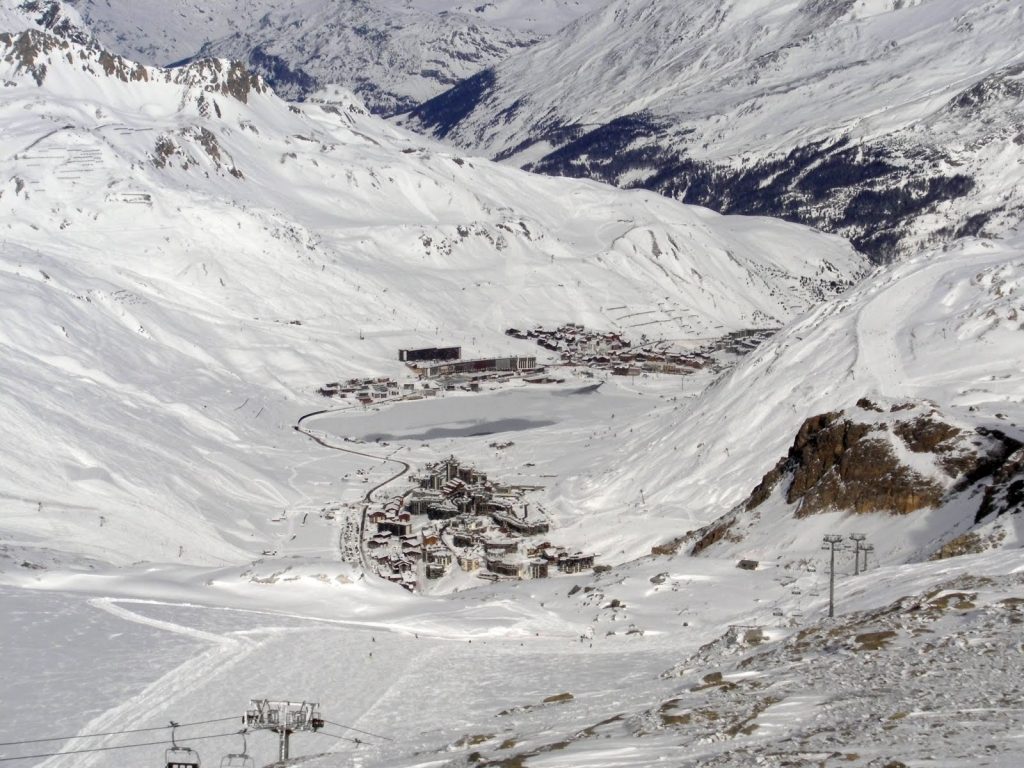Tignes today Friday 9th – looking more like a ski resort.
Worked on Gareth’s technique for a while today. His skiing is looking much tidier – especially the pivot turns in the bumps. The carving looks stronger too.
Timing (Pivot)
As technique progresses the focus shifts to different aspects. Gareth’s timing was not quite right for the short turns. When moving faster things were better due to reacting to the forces – but when moving slowly there was a clear problem. The turn was being initiated during the “up” movement instead of the down movement. Correct timing involves each turn being like a motorbike turn – down into the turn and back up out of it. It’s very easy to flip this around by mistake – particularly as ski instructors are actually taught to do this as a default action.
Carving
When carving Gareth Gareth still exhibited a large “A frame” and dropping of the inside arm behind the body – linked to rotation. The outside leg still had a tendency to be left behind and the hip joint locked up.
“A-frame”
To deal with the “A-frame” we worked on simply pulling the inside knee over towards the turn centre – something that has to be practiced until it feels natural. Gareth was able to to this to good effect. I pointed out that when doing this you can also face the upper body inwards into the turn – however it’s not obvious how this is achieved and it’s not really visible to skiers who are not aware of it.
To advance further with the other aspects it was clear that a different approach would be necessary so it was time to see if I could exploit some of the work on barefoot running and cycling technique that I’d been focused on during the summer. The crossover with those activities being clearly relevant.
Walking for Skiing
First of all I looked at Gareth walking and he made the typical mistake of reaching ahead with his foot and hip. We worked for a while at changing this so that instead he was reaching behind with the support foot and dropping the other foot just below the body – not in front of it. The point is that the power and extension of the hip come as the leg extends and to facilitate this the hip moves backwards with the spine twisting all the way up to the rib cage. Once this was being felt we then transferred the action to the support leg in skiing. The problem is that when you push the support ski ahead the hip has a tendency to follow it – but it should be going backwards relative to the foot. It’s easier to achieve this in walking because it’s what the body was intended to do with the leg extending behind it. In skiing the leg extends from a bent over or seated position so that it isn’t behind the body. The trick is to get the hip to work as if the leg was going behind. When walking or running the foot is fixed on the ground so even though it might have to be learned the whole action is 100% natural. In cycling or skiing the foot is not in a fixed position and the hip tends to follow it – so we must be aware of the need to make it go the other way. Gareth could immediately feel much stronger and more stable at high speed.
Core Muscles
The new hip action also explained how it is possible to face the upper body towards the inside of the turn. In fact the belly faces the outside ski as the hip is pulled back but the spine twists so that the chest faces inwards instead. This action activates the core muscles strengthening the entire body – especially for powerful carving. When it comes to pivoting and more vertical down/up movements this hip position allows the skier to be aware of the active use of the powerful glutes and hamstrings through the extension – so as to not be over reliant on the weaker quads (knees) doing all the work during the extension.

